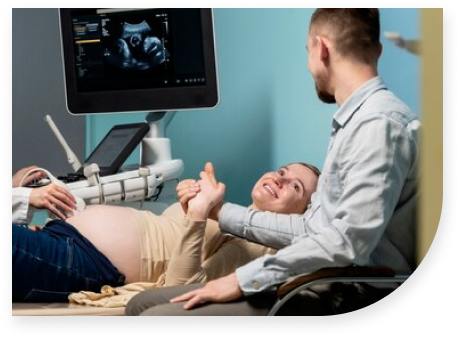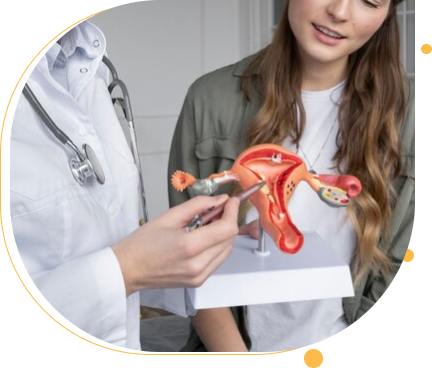Diagnosis Of Infertility & Complex Gynecological Problems

What Is Fertility Scan?
Investigation of the probable cause of infertility is complex and, in many instances, a complicated process. Investigation of the woman is based upon the availability of high-quality ultrasound with Doppler, preferably 3D USG facilities and usually involves assessment of tubal patency.
Thus, the ultrasound scan for the fertility assessment should be “one-stop procedure” called the ‘fertility scan’
To yield the best results, the scan must be performed transvaginally and the equipment should be of high resolution with sensitive colour and spectral Doppler modalities. A three dimensional (3D) facilitycan provide additional valuable information.
What’s The Best Time To Do Such Scan?

How Uterus Is Examined?
Dimensions and position of the uterus (anteverted or retroverted – both are normal ), whether the uterus is mobile, and its relation to surrounding organs (e.g. bladder, bowel) are assessed. Excluding gross abnormalities of the uterus, such as congenital anomalies, large tumours (fibroids ), polyps, and evidence of adenomyosis in the uterine wall are all important.
A trilaminar appearance (triple line) with a minimum thickness of 7 mm of the lining of the uterus and a uterine artery blood flow around mid-cycle are regarded as reliable markers of good endometrial receptivity to receive an embryo.
How Fallopian Tubes Are Examined?
A normal tube is usually invisible on ultrasound unless there is free fluid present in the pelvis. We look for tubal abnormalities, like swollen tubes (hydrosalpinx), that suggest tubal disease.
Hystero-contrast sonography (HyCoSy)offers an alternative to HSG to check whether tubes are open. Hydrosonography( SIS) is part of the HyCoSy test for enhanced evaluation of the uterine cavity.
Total pain scores for HyCoSy are reported to be significantly lower than for HSG in the majority of patients.
How Ovaries Are Examined?
Ovaries should be measured in three planes, and possibly ovarian volume should be calculated.
Each ovary should contain 5-10 antral follicles (potential eggs in each ovary) with good blood flow.
There should be a dominant follicle in one of the ovaries about 16-18 mm in diameter, with a circle of blood vessels around it, as demonstrated on colour or power Doppler in mid-cycle before the release of eggs.
On days 10-12 of the cycle, normal ovaries can be easily differentiated from those that are polycystic ovaries
Ovarian reserve is diminished when the ovarian volume is less than 3 ml or there are less than five antral follicles between the two ovaries.
Apart from assessing antral count, size of ovaries, and diagnosis of polycystic ovaries, any gross pathologies of the ovaries, such as ovarian tumours and complex ovarian cysts, are also assessed.
Detailed assessment of an ovarian cyst involves determining the character of the cyst wall (smooth versus irregular) and the intracystic anatomic appearance (septated/papillary) to assist in establishing the likelihood of a tumour, inflammatory or endometriotic process, as opposed to a simple, functional cyst.

What Else Can Be Seen Through Such Procedure?
To differentiate a pelvic infection from appendicitis, urinary tract infection, and complications of a bleeding ovarian cyst, all of which can cause lower abdominal pain. After the infectious episode, the patient may present with a pelvic mass, which can be seen.
Why 3D Ultrasound?
Three-dimensional ultrasound (3D USG) is a fast-evolving imaging technique with great potential for use in gynaecology. Patients can benefit from adding 3D USG to their routine gynaecological workup as it provides fast and accurate results in a relatively cost-effective way compared to CT scans or MRIs. As in two-dimensional ultrasound (2D USG), the transvaginal approach is preferred in gynaecologic examination with 3D USG.
Is 3D/4D Ultrasound Scanning Safe?
There has been no evidence to suggest that Ultrasound scanning presents any risk to the mother and baby. This is being monitored on an ongoing basis by experts worldwide. The Ultrasound output levels of our 3D and 4D scanning equipment, GE Voluson machine are no more than the traditional 2D scanning equipment used. While there is no hard evidence of any harmful effects of 3D/4D ultrasound, its use in non-medical situations should not be undertaken examination with 3D USG.
Here Are Some Of The Reasons For Specially Using The 3 D Usg By Tvs
Detection of congenital uterine anomalies
Assessing the Ovaries by Sonography-based Automated Volume Calculation (Sono AVC) is one for counting antral follicles and monitoring follicular growth

